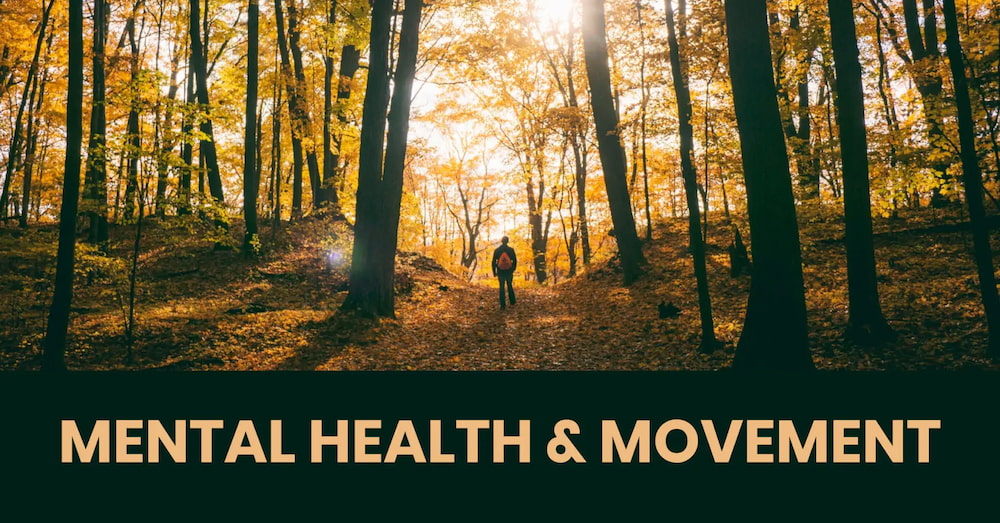
Mental health and movement
The relationship between movement and mental health
As we continue to navigate life in a pandemic and we remain fearful that our newfound freedoms could again be restricted, our mental health is an ongoing concern. During the first lockdown the headlines were dominated by facts and figures, but underlying that was another health problem – the mental wellbeing of the nation.
Pandemics aside, our mental health has been suffering as a whole, as life gets busier, living becomes more expensive and jobs and a regular income, particularly in the ever growing gig economy, become less reliable.
But it isn’t all doom and gloom, as something relatively simple could help to alleviate our mental health issues. Movement and exercise could play a significant role in giving our mental health a boost. Plus, there’s evidence to suggest that learning whilst outside using movement could boost things even further.
So let’s take a look at the evidence.
Is learning linked to our mental wellbeing?
Learning is intrinsically linked with our brain – we use the part of the brain called the cerebrum to learn. The cerebrum is also intrinsic in our memory, language, reasoning skills, creativity and sensory processing, that is, collectively, our cognitive function. It’s the largest part of our brain and it’s also where our emotions stem from.
The outer part of the cerebrum is called the cerebral cortex, which is perhaps better known as the grey matter. Which is why “grey matter” is often referred to when we talk about losing our memory or ability to learn.
But is our ability to learn linked in some way to our mental health?
Studies suggest that yes, it is.
Learning, particularly in the classroom (something that as adults we assume is for younger people, but could possibly do with a rethink) can benefit adults with moderate to severe mental health problems, and studies back this up.
One study, conducted by the University of London (UCL) Institute of Education (IOE) discovered that learning gave participants a sense of purpose that could open up new future possibilities. It also provided a sense of accomplishment at committing to a weekly lesson, learning new skills and being part of a group environment. [1]
Researchers noted that as the participants became more absorbed in their studies, low mental health scores improved.
So classroom learning can be beneficial in supporting better mental health, but could we go one better?
Learning through outdoor movement
Most of us can look back on our early years at school with fond memories. Learning through play felt innocent, we certainly didn’t realise that we were learning when we messed around in a sandpit or built things out of blocks.
Then, as we grew older, school became more about sitting down behind a desk, copying, reciting and repeating. Which certainly has a place, but could mainstream UK schools look to the North of Europe to learn a little more about how to learn and therefore support the mental health of children and future adults? After all, around a third of all UK pupils lose their desire to learn or go to school by the later years of secondary school. [2]
Scandinavian countries have a compulsory educational policy that all seven to 16 year olds should receive lessons outside of the traditional indoor classroom either weekly or fortnightly. They even have a word for it – udeskole, which translates to outdoor school. [3]
This means that children learn in forests, farms, parks and local places (and indoor settings such as factories and galleries too) as well as in the classroom.
Visiting local neighbourhoods on foot, exploring surroundings and experiencing nature are all on the curriculum. Movement is also encouraged, for example during outdoor maths classes that involve jumping, relay races and practicing times tables whilst throwing and catching balls and playing hopscotch.
Early studies show that learning in an outdoor environment has benefits for increased levels of learning as well as increasing the physical activity of children. Perhaps most significantly, this increase in outdoor physical activity and learning also has a positive impact on the physical and emotional wellbeing of children. [4]
Leaning in an outdoor setting looks like it could be at least one answer to the complexities of human emotional wellbeing.
Movement and mental wellbeing
So could it be then, given that learning can support better mental health and that we can learn better through movement, that movement and exercise can boost our mental wellbeing?
Absolutely it can.
The benefits of exercise to our mental health are multiple. These include reducing levels of stress, anxiety and depression, creating a more positive mindset and mood, improving low self-esteem, sleep, energy and stamina and crucially, our cognitive function. [5] Not to mention the weight management benefits of exercise that then contribute to improved overall mental wellbeing.
We could then see it as a virtuous cycle – movement improves learning and cognitive function, an improved level of learning and cognitive function increases our desire to move and so on.
Furthermore, the benefits of being outside to our emotional wellbeing are also significant. Being in nature reduces stress levels and feelings of anger and promotes a feeling of relaxation.
What’s more, studies show that green open spaces in view of the classroom and the home promotes better self-control in children, benefitting their ability to learn. The same studies show that adults with nearby green space experience “improved working memory, cognitive flexibility and attentional control”. [6]
Being outside, movement learning and mental health
Learning gives us a sense of purpose, achievement and pride. Being outside can promote learning. These factors alone are a boost to our mental health, but even if we’re not learning outside, and we’re simply moving such as a bracing beach walk or a countryside stroll, we’re improving our mood and decompressing from the stresses and strains of life.
Incorporating a daily walk or time outside into your life could have significant improvements for your mental wellbeing. You could also boost your learning. Given that it’s free and simple for most (even if we’re urban city dwellers, there’s still a world outside to discover) what’s the harm in trying?
So go on, head out. Your mood will thank you for it.
References
1. Institute of Education. 2021. Learning helps wellbeing of adults with mental health problems. [online] Available at: <https://www.ucl.ac.uk/ioe/news/2020/jan/learning-helps-wellbeing-adults-mental-health-problems> [Accessed 25 November 2021].
2. Children and Nature Network. 2021. UDESKOLE IN SCANDINAVIA: Teaching and Learning in Natural Places – Children and Nature Network. [online] Available at: <https://www.childrenandnature.org/resources/udeskole-in-scandinavia-teaching-learning-in-natural-places/> [Accessed 25 November 2021].
3. Bentsen, P., Mygind, E. and Randrup, T. (2009) ‘Towards an understanding of udeskole: education outside the classroom in a Danish context’, Education 3-13, 37(1), pp.29-44. [Accessed 25 November 2021]
4. Bentsen, P., Jensen, F., Mygind, E. and Randrup, T. (2010) ‘The extent and dissemination of udeskole in Danish schools’, Urban Forestry and Urban Greening, 9(3), pp. 235-243. [Accessed 25 November 2021]
5. Sharma, A., Madaan, V. and Petty, F. (2006) ‘Exercise for mental health’ Prim Care Companion J Clin Psychiatry, 8(2) pp. 106. [Accessed 25 November 2021]
6. Schertz, K. and Berman, M. (2019) ‘Understanding Nature and Its Cognitive Benefits’, Current Directions in Psychological Science, 28(5), pp. 496-502. [Accessed 25 November 2021]


